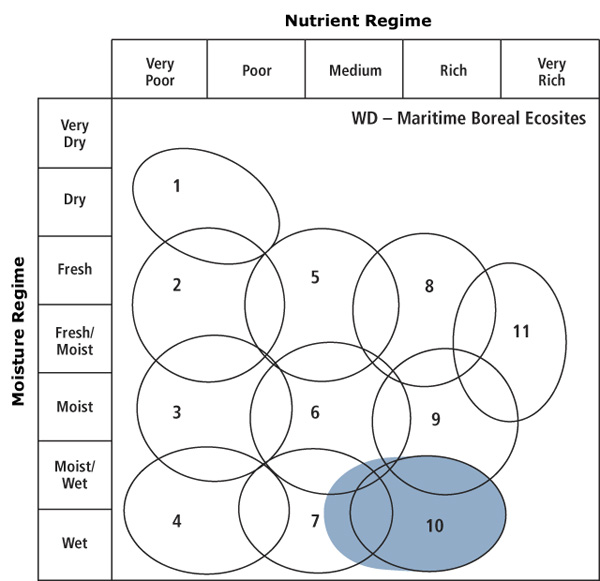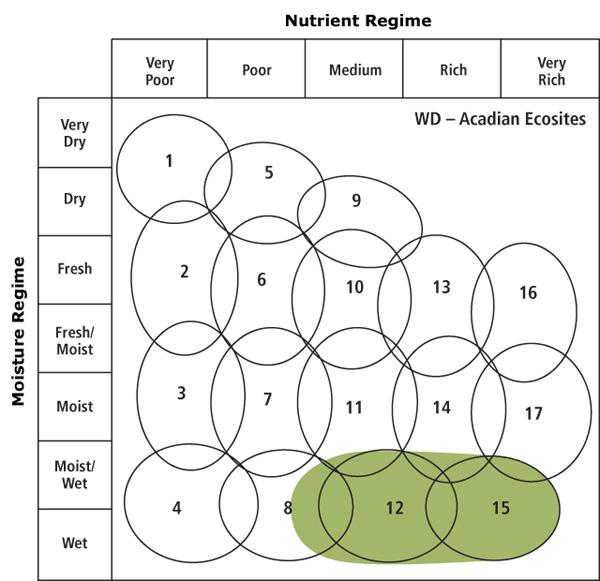
Wet Deciduous Forest Group (n=89)
WD1 — White ash / Sensitive fern – Christmas fern (n=11)
WD2 — Red maple / Cinnamon fern / Sphagnum (n=8)
WD3 — Red maple / Sensitive fern – Lady fern / Sphagnum (n=11)
WD4— Red maple / Poison ivy / Sphagnum (n=27)
WD4a — Huckleberry – Inkberry variant
WD5 — Trembling aspen / Beaked hazelnut / Interrupted fern / Sphagnum (n=7)
WD6 — Red maple – Balsam fir / Wood aster / Sphagnum (n=7)
WD7 — Balsam fir – White ash / Cinnamon fern – New York fern / Sphagnum (n=12)
WD8 — Hemlock / Cinnamon fern – Sensitive fern / Sphagnum (n=6)
Concept: These are wet forest ecosystems with water at or near the surface for most of the year. They are generally dominated by hardwood species such as red maple and white ash, but also include mixedwood forests with balsam fir. The shrub layer is mainly regenerating tree species, while the well-developed herb layer includes many species of ferns and sedges. Moss abundance is low to moderate. Vegetation Types (VT) are associated with moderate to high nutrient availability with increasing richness indicated by white ash presence. They occur primarily on level to depressional topography with soils derived from either mineral or organic parent material. All VTs in this group are found in the Acadian Ecosite group, with some red maple and balsam fir dominated VTs also found in the Maritime Boreal Ecosite group.
Vegetation: Crown closure can be moderate to high in VTs of this group, but some stands only support widely spaced trees. Red maple is the main overstory species, with other VTs distinguished by trembling aspen and white ash cover. Mixedwood VTs in this group are dominated by red maple with balsam fir or red spruce. Yellow birch, sugar maple, white pine and hemlock can sometimes be found on better drained hummocks. The shrub layer mainly contains regenerating tree species, alder, winterberry and false holly. The herb layer is dominated by sensitive fern, cinnamon fern, lady fern and dewberry. Poison ivy is also found in western Nova Scotia. Sphagnum moss coverage
is often extensive.
Environmental Setting:Vegetation types in this group are found on upper and lower flats, lower and toe positions of gentle slopes, shallow depressions and riparian zones. Most sites have little (if any) surface stoniness or exposed bedrock. Soils are generally derived from glacial till, fluvial, lacustrine and/or organic deposits, with fertility enhanced by ground water or seepage inputs. Rooting depth is strongly limited by high water levels. Various VTs form small to large patches on the landscape. This group is found throughout the province, but is prominent in the Northumberland Bras d’Or Lowlands (500), Valley and Central Lowlands (600) and Western (700) ecoregions.
Successional Dynamics:These wet hardwood and mixedwood forests are mainly edaphic climax associations maintained by excessive moisture. Fluctuating water levels, windthrow, insects and disease are significant disturbance agents. Stands within a given VT may display a range of development stages depending on disturbance history and natural senescence.

Ecological Features: Most ecosystems from this group occur on wet soils but some are infrequently found on moist upland sites. Wet deciduous forests are relatively common small patch ecosystems, making unique contributions to landscape structure, hydrologic regime and habitat diversity. Stands often feature small pools of standing water, irregular surface topography and slow moving streams. Organic accumulation in wet deciduous forests is usually lower than in wet coniferous forests, while water flow and nutrient availability is generally higher. Especially wet stands may persist as woodlands, with stunted trees and marsh and/or fen understory species. Wet deciduous forests may provide habitat for invertebrates, lichens, amphibians (e.g. wood frogs, yellow and blue spotted salamander), reptiles (e.g. wood turtles, ribbon snakes), mammals (e.g. moose, water shrew), plants and birds (swamp sparrow, common yellow throat, woodcock, wood thrush, Canada warbler and northern waterthrush). Edaphic climax forests in this group are self sustaining, and many express long term ecological continuity. However, stand dynamics and old growth development are not well understood.
| 1a. Stands with < 25% softwood in the overstory | 2 | |
| 1b. Stands with > 25% softwood in the overstory | 6 | |
| 2a. White ash abundant to dominant | WD1 White ash / Sensitive fern – Christmas fern | |
| 2b. White ash absent to scattered | 3 |
|
| 3a. Red maple abundant to dominant | 4 | |
| 3b. Trembling aspen abundant to dominant | WD5 Trembling aspen / Beaked hazelnut / Interrupted fern / Sphagnum | |
| 4a. Atlantic Coastal Plain flora present | WD4 Red maple / Poison ivy / Sphagnum | |
| 4b. Atlantic Coastal Plain flora absent | 5 | |
| 5a. Stands with understory plants indicating enriched conditions (sensitive fern, lady fern, dwarf raspberry, violets, jewelweed) | WD3 Red maple / Sensitive fern – Lady fern / Sphagnum | |
| 5b. Stands with the above species absent or nearly so, indicating a poorer condition, cinnamon fern usually >10% cover with the following upland species (bunchberry, bracken, teaberry) often present | WD2 Red maple / Cinnamon fern / Sphagnum |
|
| 6a. White ash absent | 7 | |
| 6b. White ash sparse to scattered | WD7 Balsam fir – White ash / Cinnamon fern – New York fern / Sphagnum |
|
| 7a. Balsam fir is the most common softwood | WD6Red maple – Balsam fir / Wood aster / Sphagnum | |
| 7b. Spruce are the most common softwood | WD8 Red spruce – Red maple / Wood sorrel – Sensitive fern / Sphagnum | |
